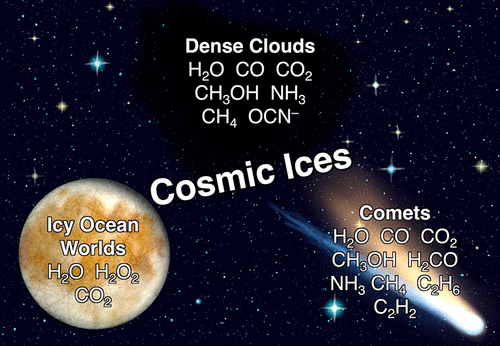当前位置:
X-MOL 学术
›
Acc. Chem. Res.
›
论文详情
Our official English website, www.x-mol.net, welcomes your
feedback! (Note: you will need to create a separate account there.)
Laboratory Studies of Astronomical Ices: Reaction Chemistry and Spectroscopy
Accounts of Chemical Research ( IF 16.4 ) Pub Date : 2020-12-31 , DOI: 10.1021/acs.accounts.0c00637 Christopher K. Materese 1 , Perry A. Gerakines 1 , Reggie L. Hudson 1
Accounts of Chemical Research ( IF 16.4 ) Pub Date : 2020-12-31 , DOI: 10.1021/acs.accounts.0c00637 Christopher K. Materese 1 , Perry A. Gerakines 1 , Reggie L. Hudson 1
Affiliation

|
Scientists have had evidence for molecules in both comets and interstellar space since the 19th and early 20th centuries. Since then, extraterrestrial molecules ranging from simple diatomics to C70 to amino acids have been detected and identified through remote spectroscopy, spacecraft, and sample return missions. These achievements have been made through the efforts of astronomers and laboratory chemists collaborating to identify molecules in a myriad of exotic environments. It is now understood that even in the coldest depths of dense molecular clouds there is a wealth of chemistry to explore, much of it driven by exposure to radiation. As molecular clouds condense to protostellar disks and eventually form new planetary systems, chemical processes continue and evolve. An understanding of these processes is paramount for explaining the compositions of different bodies in our Solar System and may provide insight into the origins of life.
中文翻译:

天文冰的实验室研究:反应化学和光谱学
自19世纪和20世纪初以来,科学家已经有证据证明在彗星和星际空间中都有分子。从那时起,地外分子从简单的双原子分子到C 70通过远程光谱学,航天器和样品返回任务已经检测到并鉴定出氨基酸的残留量。这些成就是通过天文学家和实验室化学家共同努力,在众多异国环境中鉴定分子而取得的。现在已经知道,即使在致密分子云的最冷深度,也有大量化学物质可供探索,其中许多化学物质是受辐射驱动的。随着分子云凝结到原恒星盘并最终形成新的行星系统,化学过程继续并发展。对这些过程的理解对于解释我们太阳系中不同物体的组成至关重要,并且可能提供对生命起源的洞察力。
更新日期:2021-01-19
中文翻译:

天文冰的实验室研究:反应化学和光谱学
自19世纪和20世纪初以来,科学家已经有证据证明在彗星和星际空间中都有分子。从那时起,地外分子从简单的双原子分子到C 70通过远程光谱学,航天器和样品返回任务已经检测到并鉴定出氨基酸的残留量。这些成就是通过天文学家和实验室化学家共同努力,在众多异国环境中鉴定分子而取得的。现在已经知道,即使在致密分子云的最冷深度,也有大量化学物质可供探索,其中许多化学物质是受辐射驱动的。随着分子云凝结到原恒星盘并最终形成新的行星系统,化学过程继续并发展。对这些过程的理解对于解释我们太阳系中不同物体的组成至关重要,并且可能提供对生命起源的洞察力。











































 京公网安备 11010802027423号
京公网安备 11010802027423号